The Body
The body of a wagon or van would be made from planks of wood, generally
an inch or so thick by about six inches wide, bolted to a supporting framework.
The whole assembly was held together with `coach bolts' (note that when one
hears of `rivet detail' being applied to wooden bodied stock the `rivets' were
in fact the heads of the bolts).
In the early years the reinforcing
framework on both wagons and vans was made of wood and was usually on the
outside of the body, so called 'outside framed' designs. This left the inside
clear of obstructions but the external frames collected water and promoted wood
rot. Open wagons had generally switched to metal plate reinforcing (usually
called 'strapping') by the 1860's but vans retained the wooden frames much
longer. Van frames were generally moved inside the vehicle by the early 1930's
and sometimes an inner lining of wood was applied to provide a smooth interior.
Wood-framed van designs with the framing on the inside continued in production
up to the 1970's.
On wooden bodied mineral wagons it was common
practice to add a metal strip called a curb rail to the top of the wagon side
to protect it from falling coal and shovels as the wagon was loaded or
unloaded. Similar rails were also fitted to some open wagons to prevent people
nailing anything to the top of the side planks (this is discussed in more
detail in the section on Cargo and Wagon Loads).
The end-door on main
line mineral wagons appeared in the 1880's and they were a common though not
universal fitting on coal wagons by the turn of the century.
Iron
bodies for both open wagons and vans were produced in the 1870's and there was
much debate at the turn of the century on the merits of iron bodied vehicles.
Metal bodied stock was more robust than wood and iron vehicles weighed less,
allowing a higher payload. Against this repairs were more difficult as the
wrought iron plates were riveted together and rust replaced rot as the main
problem. In general metal was only found to be worthwhile for mineral wagon
bodies and even these were still mainly built of wood up to the late 1930's.
The GWR, and several of the Welsh railway companies it absorbed, owned
a great many `Iron Mink' general purpose vans. These vans had an iron body made
up of panels riveted together with hinged wooden side doors. Introduced in the
1880's the last GWR examples were built in 1901, with a few bogie types built
in 1911. Iron bodied vans were a long lived breed and proved popular with
private owners, notably with cement firms who bought or leased a number of such
vehicles, often painting them in colourful liveries.
Some of these iron
vans remained in service long enough to become British Railways 'departmental
stock'. The examples in departmental use shown below were used as stores vans
at small Welsh stations, vans used in this way featured the large letter X in
the data panel area as shown. The plain wagon doors shown on the lower van date
from 1927, these replaced the original standard GWR design with its outside
frame as shown on then upper van. Sometimes the older pattern doors had a
diagonal wooden brace running from the outer bottom corner to the inner top
corner. These wagons were photographed, still in departmental service, in the
late 1960's.
Fig ___ Iron bodied vans

The lower illustration shows a van with one end vent cover removed,
the black 'dots' are the holes in the metal end plate under the cover.
Early designs of iron
bodied vehicles had rounded corners on both the open wagons and van type
bodies. These corners were separate plates, they added strength and meant that
heavy corner posts were not required. The Peco Butterly steel wagon, in the
guise of a GWR coal wagon, should have plain ends with rounded corners, a going
over with sand paper does the trick, then just add vertical posts to the ends
from microstrip and paint out the diagonal white line on the side (these wagons
had no end door, which is what the line is to indicate). Not all iron bodied
stock had rounded corners however, most iron vehicles built after the turn of
the century (gunpowder vans and mineral wagons) had square corners, so get a
good look at a photo if modelling a specific prototype. The square cornered
version of the GWR iron vans, lined with wood, fitted with iron doors and
supplied with a pair of leather `nailless' over-boots, became the basis for the
standard RCH approved `Gunpowder van'. This design, with minor variations, was
used by most pre-1923 companies, the post-1923 Big Four railway companies and
by British Railways for explosives.
A kit of the standard Iron Mink
van, with rounded corners and late pattern vertically planked inside framed
doors, is available to members of the 2mm Scale Association. To convert this
into an early gunpowder van carve off the end vents, sand smooth the doors to
represent sheet metal, add a door locking bar to the right hand door and new
hinges. More recently the N Gauge Society have introduced an N scale model of
this van, the model comes with alternative doors to allow the gunpowder van
variant to be made and the society even offers suitable transfers.
Iron
vans, including gunpowder vans, can also be produced from the Peco standard van
by sanding all detail from the sides and ends, sanding the corners to a curved
section if required, and lowering the roof by about two or three millimetres.
Detail such as outside reinforcing frames, handles and doors can then be added
using plastic strip, rod and sheet.
Fig ___ Models of iron mink
vans

The models shown
were all made from the 2mm Scale Association kit many years ago. They first ran
on cut down Peco ten foot wheelbase chassis but are now mounted on the Peco
nine foot wheelbase chassis. There should be three bands across the roof of the
gunpowder van (I only found out about those after making and painting the
model). These kits are to 2mm scale and come with the post 1927 type doors,
other door types require modification. The N Gauge society now offers a kit for
the type in N Scale (1-148) which comes with alternative doors and even
transfers (including a colourful cement van livery).
In the early days
the only explosive available was black powder or 'gunpowder', Tri Nitro
Cellulose or 'Guncotton' was invented in 1846 and a year later an Italian
discovered Nitroglycerine, a very powerful explosive but too unstable to
transport safely. In 1866 the Swede Alfred Nobel found that mixing
nitroglycerine with a clay called kieselguhr rendered it less volatile, he
called this new explosive Dynamite. He then discovered that mixing
nitroglycerine with gun-cotton produced a jelly like explosive which is called
blasting gelatine. Both Dynamite and blasting gelatine are very high
explosives, they tend to shatter things. Nobel went on to develop ballistite (a
variation on blasting gelatine) which is a lower explosive, offering a pushing
action rather than a destructively shattering one. The British decided to use
ballistite, without paying any royalties to Nobel, and called their product
'cordite'. Ballistite and cordite enabled people to build better firearms and
Nobel was so horrified by the use to which his wares were put he founded the
Nobel Prize for people doing work for the benefit of mankind. By 1914 the
military were using TNT (Tri Nitro Toluene) and by the outbreak of the Second
World War a range of stable explosives had been developed notably PETN and
Cyclonite. By the mid 1930's Britain was using over twenty thousand tons of
non-military explosives a year, mostly in the coal mines. Dynamite was by far
the most widely used explosive in the mines up to about 1955 but new explosives
which are safer and more efficient have now largely replaced it. These are
based either on a mixture of ammonium nitrate and fuel oil (commonly referred
to as ANFO) or ammonium nitrate mixed with a thickening jelly like material,
sensitised with TNT. The latter are called slurry blasting agents or SBA.
Quarries generally preferred old fashioned 'low explosive' and cheap 'black
powder' up to the mid 1950's. Black powder was shipped in small casks and the
stick-formed explosives preferred by mines were shipped in small wooden boxes.
Steel became a viable wagon building material in the mid 1920's, and by
the end of the decade 'pressed steel' panels began to appear in new wagons.
Pressed steel is sheet metal which is pressed in a mould to form ribs or bulges
which give strength and rigidity to the panel. Examples are the ribbed ends on
the Graham Farish single vent van (dating from the late 1920's) and the doors
on the Graham Farish steel open wagon (dating from the 1940's). Pressed steel
offers a low weight for a given strength and from the 1920's several companies
built road/rail containers in this material.
The wagon shown below, sketched from a photo in Peter Mathew's book on PO Wagons (see bibliography) is an all steel wagon equivalent to the three plank design built in 1923 to the then new RCH specification. The livery is that of the wagon builder although it may have operated in this livery for a time before being repainted in the owners colours.
Fig ___ PO steel bodied road stone or tarmacadam wagon

Iron was preferred to
steel for goods stock bodies prior to the 1930's because it was less prone to
rusting and better able to withstand shock loads when shunting. Steel chassis
however became increasingly common after the turn of the century. The early GWR
'Felix Pole' mineral wagons used wrought iron bodies on a steel chassis. The
LNER were noted for experimenting with iron bodied stock, although they
generally preferred wooden underframes long after most of the other companies
designs had shifted to metal
The GWR was in the forefront of metal
underframe development. They built a large number of steel mineral wagons and
in 1934 they built fifty or so steel bodied open wagons to the same general
dimensions as the five plank open wagon. These steel merchandise wagons had a
wooden floor and a wooden inner lining to the drop-down doors (to give a better
grip to working boots when loading). The diagonal strapping on the sides was a
thin L section and the verticals to either side of the doors was also L
section. The ends supports were T section and the capping strip along the top
of the sides was fine L section. My model was made by carving and sanding the
sides and ends of a Peco 5 plank wagon body until they were flat. The heavy L
section strapping to either side of the doors was represented using 20x30 thou
strip, with a strip of 10x10 thou laid beside it (on the door side). The end T
section was also 20x30 thou but with 10x10 thou to both sides. Had I sanded
down the 20x30 thou to a thinner section (about 10x30 thou) it would have
looked better. The fine L section diagonals were 10x20 thou with a strip of
10x10 thou laid on top to one side, the top capping strip was just 10x10 thou
laid along the top of the side. The LNER built a number of steel bodied wagons
in 1945, the later type with a steel door and dimples on the sides is available
from Parkwood Models, mine is a Peco butterly wagon with the ends sanded smooth
and a door section cut from a Peco five plank wagon set into the centre
representing the early models. This is a five plank door not six plank but from
normal viewing distance I think it looks okay.
Fig ___ GWR and LNER
steel bodied goods open wagons
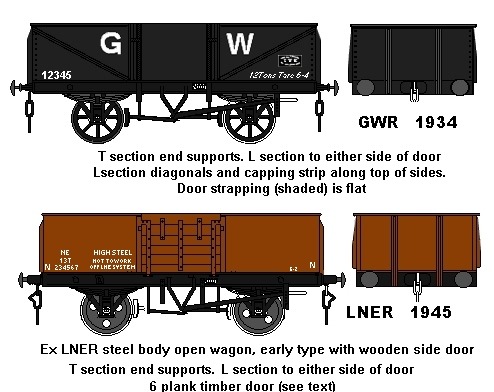
The Peco 'Butterly' steel wagon is a design dating from 1935, however very similar wagons were built earlier than that date.
The LNER built
some concrete bodied brake vans to their standard pattern (the Queen Mary
design, similar to the Minitrix model), but this was not a success. In 1945 the
LNER built some steel bodied open wagons on a steel chassis. These were built
with both wooden and steel doors and some of the latter type had distinctive
'dimples' on the sides where securing rings were fitted internally. Some of the
steel doored type were fitted with a vacuum brake for use in the Green Arrow
all-fitted goods service and under British Railways the unfitted wagons in this
series were fitted with vacuum brakes. The version with steel doors is
available in the Parkwood Models range of kits and these remained in service
into the 1970's.
The roof on most vans was wooden tongue and groove
planking laid lengthways and pulled down to follow the curve of the roof using
a metal frame forced down with 'bottle screws' or 'turnbuckles'. The planks
were then nailed down and covered with tarpaulin which was nailed into place
under the `eaves'. The roof was coated usually with a white lead based paint
for water-proofing, some companies used tar, producing a black roof. After the
1930's some van roofs were painted with an aluminium paint, giving a silvery
grey finish, but this was not common. This wood and cloth roof remained
standard well into the British Railways era, with only a few experiments into
the use of fibreglass, sheet metal or plastic taking place prior to the
introduction of the modern air-braked stock.
An iron roof was sometimes
used on wooden bodied rolling stock, these can usually be spotted because they
had rounded rather than square corners and two or three narrow iron strips
across the top riveted over the joints in the roof sections. The early GWR
'Mex' wooden bodied cattle wagons (as available from Peco) had an iron roof and
these had the three strips evenly spaced along them.
On pre-war stock
the nails used to attach the canvas to wooden roofs sometimes poked through
into the inside of the vehicle. Where this was a problem, such as on cattle or
other livestock vans and the roofed wagons used for carrying bagged salt, it
was standard practice to add wooden strips across the roof and drive the nails
down through these to ensure they did not penetrate through into the inside of
the vehicle. These strips, generally at about two foot intervals along the
roof, are quite noticeable in photographs of older vehicles.
Several of
the pre-grouping companies built vans with a removable section of roof (an
example of this can be seen on the Graham Farish ex NER bogie van). The idea
was to allow heavy loads to be lifted in by a crane. The opening in the roof
was usually covered by a roof door, which could be slid either to the side or
more commonly from one side to the other. Not all vans had the door however, on
some vehicles a simple tarpaulin cover was used. Problems with leaking, and the
extra cost of building a van with these roof doors meant that they were
progressively phased out and few were built after the turn of the century.
There were a limited number of vans built with a peaked roof. Most were
private owner vehicles (such as the Peco and Graham Farish salt and lime
wagons) but a few were built for smaller railway companies. The Garstang &
Knot End Railway in Lancashire converted some old eight plank goods wagons to
peaked roof vans to carry bagged salt. The wagons were originally dumb-buffered
and had only a seven foot wheelbase. I understand that the resulting vans had
horizontally planked sides ten planks high with a single side-hinged door in
place of the open wagon drop door. These vans survived into LMS ownership but
apparently they were scrapped before carrying any cargo under the new owners
and there is no record of any being re-painted in LMS colours.
Fig
___ Garstang & Knott End Railway Van

Modelling these vans is discussed in Railway Modeller March 2002
(Traffic for Tickling Article 8). I built a couple for a Light Railway
layout.
For further information on this company see The Garstang &
Knott End Railway - R. W. Rush & M.R.C. Price, Oakwood Press (1985) ISBN 0
85361 318 4 (available through the library system).
Vans tend to heat
up, especially in summer, and certain cargo required ventilation. The most
extreme expedient was to miss out alternate planks on the sides as seen on the
slat-sided vans used for milk and beer traffic. Slightly more sophisticated
were openings covered with slats of wood, and some fish vans had these, an
example being the Graham Farish fish van, a Great Northern Railway design which
has slatted upper sides. The drawback of both alternate planking and slats was
simply that they let in the rain.
Louvered openings cost more, were
more difficult to maintain and were more likely to get damaged, but they did
keep out the rain. Small louvered openings were used on meat vans and some fish
and milk van designs had louvers all along the sides, anything from a third to
half the height of the vehicle. The lower portions of these milk van sides were
solid planking due to the danger of damage as the heavy milk churns were
man-handled inside. An good example is the Lima model of the GWR Siphon G,
which has louvers along the upper sides. Louvered openings, being pretty well
rain proof, enabled these vehicles to be used as parcels vans when milk churn
traffic declined.
The early GWR Mink C van (available as a kit from the
N Gauge Society) has louvered ventilators on the ends. Where ventilation might
be optional or required a degree of control a standard technique in the early
years was to fit a louvered opening which could be covered by a sliding wooden
shutter. This idea did not catch on however and these shutters, which were
never very common, were often removed later. By about the 1890's most companies
had switched to using simple slatted openings in the ends of the body, covered
by a shaped metal hood or bonnet. Examples of these will be seen on the ends of
the Peco ventilated van and the Graham Farish twin vent vans. Iron bodied vans,
such as the GWR Iron Mink, had rows of one inch diameter holes under the
ventilator bonnet. These holes can be included in an old iron van body being
used as a rough store at some outlying station. British Railways meat vans and
some fruit vans had additional small oblong 'air scoop' ventilators built into
their lower sides and the meat vans often had louvered openings on the upper
sides as well as the ends.
The final form of ventilation was the roof
ventilator. Early designs were many and varied, some were simply a T shaped
tube, from which were developed the 'torpedo' ventilators. These proved popular
and were used by the LMS and LNER for goods and some passenger vehicles. The
alternative was the 'shell' ventilator, which was often seen on passenger and
non-passenger coaching stock and which was used by both the Southern Railway
and Great Western railway for goods vans as well.
Fig ___
Ventilators
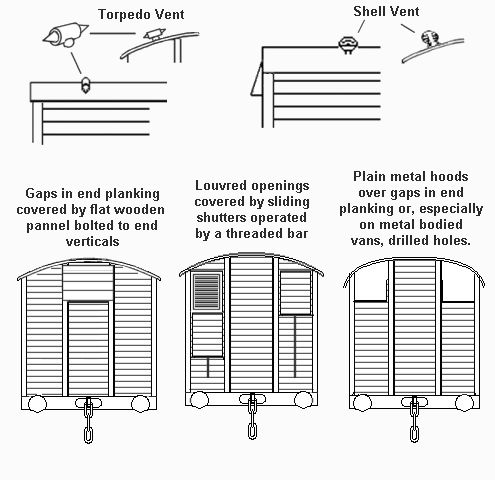
There
are roof ventilators available from various suppliers, I am still using up a couple
of packets of cast metal 'shell' ventilators by Beaver that I bought in the
early 1980's. Ultima, the firm who offer a range of passenger coach models,
offer some very neat torpedo and shell ventilators and every bits box would
benefit from a couple of packets of each. Most ventilators are sold for use
with coaches, so you get a lot in a packet, and the improvement in appearance
with a few vans in a rake appropriately fitted is well worth the effort. Having
said which I do have a few vans with 'shell' vents made by crushing the head of
a Peco track pin and you do have to look rather closely to see the difference.
By the middle of the Second World War all the companies were producing
some of their vans with plywood side panels instead of planks as an economy
measure. They were outwardly identical to standard planked designs but lacked
the lines of planking. To model these the best option is simply to sand all the
detail off a Peco Insulated Van kit then add strapping, doors and other details
from microstrip, microrod and plastic card.
Fig ___ Big-Four Plywood
vans
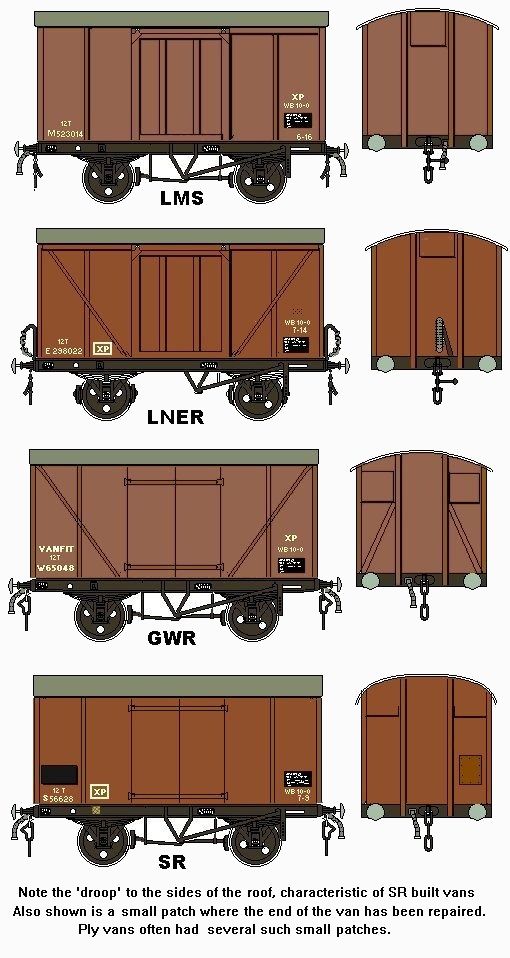
After nationalisation British Railways built versions of its own
standard van designs with plywood sides, these are illustrated in the section
on Post Nationalisation Wagon Development.
Standard Wagon and Van
Designs
Flat wagons with no sides or ends and one plank wagons have
been used by all the railway companies. Early four wheeled types could carry
smaller farm implements (loaded from the side) or heavy materials such as
blocks of stone. Do remember that the load on a one plank wagon was not
necessarily small, as an example bales of cotton and wool were piled quite high
on these wagons, covered with a tarpaulin and roped securely in place.
Fig ___ Sketches of a one plank wagon with cotton bale load before
and after covering with tarpaulins.
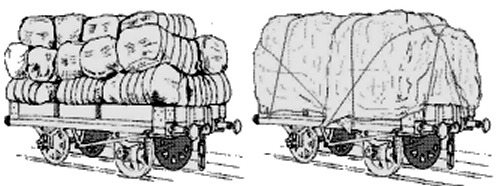
One, two and three plank wagon were common up to about 1890, but
were increasingly replaced by higher sided open wagons after that. It is worth
noting that two plank wagons were never as common as the one and three plank
types.
The RCH specification of 1887 had a marked impact on wagons
design and from the 1890's to the 1970's the open three, four or five plank
(high sided) wagons were the most common type used for general merchandise.
These were recognisable cousins of the RCH standard mineral wagon.
The
one plank (low) wagons and three plank (medium) wagons sometimes had sides
which hinged down along the bottom edge. Four and five plank open wagons were
equipped with side doors which dropped down to form a ramp onto the platform.
These doors were called `sack-truck' doors as they permitted staff to wheel the
standard two wheeled porters trolley (or sack truck) in and out of the wagon.
The four plank wagons were common on the GWR, although they switched to five
plank designs after abut 1900. The top plank on wagons taller than three planks
was usually wider than the lower three which modelling the four plank type a
little difficult. You can do it by cutting the top plank from a Peco five plank
wagon then cutting the next plank down away and re-fitting the top section. I
have tried this but to date the results have been disappointing.
Higher
seven or eight plank general merchandise wagons were also built, usually with
two cupboard style outward opening doors at the top of the standard five plank
'sack-truck' drop door. The Peco seven plank open wagon can be easily modified
to represent this kind of vehicle.
Fig ___ High Open Merchandise
Wagons
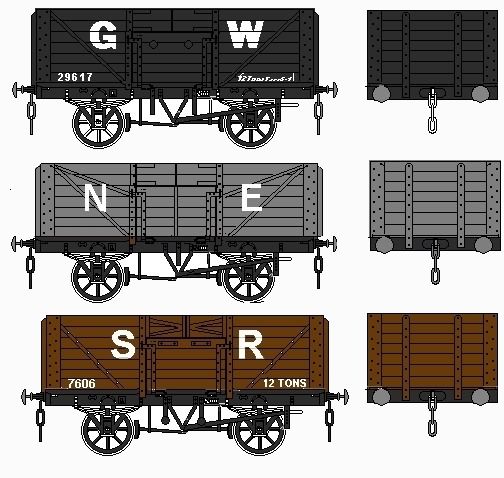
Some odd designs were to be seen, the Lancashire & Yorkshire
Railway built a number of three plank open wagons on a twelve foot wheelbase
chassis which had fixed sides but drop down ends. These wagons could be
conveniently loaded from an end loading dock, but otherwise cargo had to be
lifted in to it by hand or crane. They survived into LMS ownership and under
that company the white diagonal stripes indicating end doors were painted on
the sides in the form of a shallow V not quite meeting at the bottom. Some of
these wagons had one end screwed shut, the remaining end retained its hinges
and a single diagonal white line was painted right across the side, rising to
the door end.
Some seasonal traffic such as fruit also attracted
special wagons, fruit vans were built from the 1890's but there were seldom
enough available. Fruit and vegetables often travelled in cattle wagons with a
tarpaulin over the top to keep out rain and prevent pilfering. Wood pulp, sugar
beet, imported esparto grass and most other seasonal traffic was carried in
standard wagons.
It was usual to add a tarpaulin over the load to
protect it from rain and to a lesser extent from pilferage. The tarpaulin was
fastened in place using ropes which could be tied to hooks provided on the
chassis of the wagon. The ropes were often also tied through the holes or hooks
on the chassis provided for attaching horses and they were also looped over the
buffers. Tarpaulins were sometimes seen draped over vans with leaking roofs or
cattle wagons being used for fruit traffic. As noted earlier some open wagons
had a fixed wooden bar to support the tarpaulin, some were fitted with curved
raised ends to lift the tarpaulin. These raised ends were a feature of several
general merchandise open wagon designs in the South prior to the 1923 grouping
but by the mid 1920's they were increasingly confined to private owner wagons
such as lime and salt stock. From about the turn of the century some open
wagons were equipped with a hinged steel bar, as seen on the Peco long
wheelbase 8 plank open wagon. These `patent' hinged tarpaulin rails were an
expensive item and were usually removed from stock pooled under the common user
scheme after the First World War. The Peco fifteen foot wheel base 'tarpaulin
wagon' is a British Railways development of an older ten foot wheel base
Southern Railway eight plank general merchandise wagon. This in turn was based
on a design by the LSWR. The LSWR or SR wagon can be modelled by cutting the
door section and the end sections from the tarpaulin wagon and assembling them
on a 10 foot wheel base chassis. Some of these survived well into the BR era.
Fig ___ Peco long wheel base tarpaulin wagon cut down to LSWR/SR
type
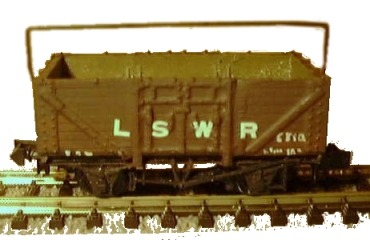
Goods carried in open wagons were vulnerable to pilferage
and the tarpaulin was often less than effective in protecting the contents from
rain. Several companies increased their stock of vans at one time or another to
reduce these problems. The various railway companies had differing policies on
vans, some favouring sliding doors others preferring hinged types. After the
1923 grouping the LMS and LNER opted for sliding door types in the main, whilst
the GWR and SR preferred hinged doors. The problems came when a GWR or SR van
arrived at a depot with higher than normal platforms but this did not occur
very frequently. When it did happen the vehicle was shunted clear (by men or
horses), the doors opened and the vehicle shunted back.
Vans with
moveable internal partitions were introduced in the mid 1930's, when road
transport was making an impact and it was not practical to wait until a van was
full before dispatching it. These added to the cost of the van and they were
usually reserved for high value cargoes such as eggs.
Shock Absorbing Vehicles
Shock absorbing vans and
open wagons, in which the body sits on a spring-loaded frame and can move
lengthways on the chassis to absorb more of the impact when shunting, were
introduced in the mid to late 1930's. As my own interests are mid 1920's and
mid 1960's I have not made many notes on the pre-BR shock absorbing vehicles
however the notes which follow should serve as a guide for these.
Shock-absorbing vehicles were aimed at cargo such as bone china and the
like, which were then still largely conveyed by the canals (I believe some
shock absorbing vans were also used for eggs). BR built a number of shock
absorbing vans and opens, one common cargo for the latter being bricks and
roofing tiles. The pre-war and early BR shock absorbing wagons and vans
employed a shortened standard body on a standard seventeen foot six inch
chassis fitted with the shock absorbing gear. On early examples the springs
were visible on the sides of the chassis but following a number of accidents it
became standard practice to cover the springs in sheet metal.
Fig___
Shock Absorbing chassis
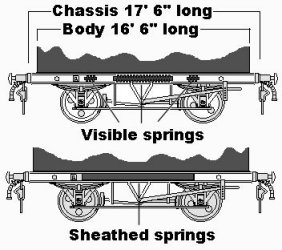
The visible spring type can
be modelled in N by adding three lengths of 1mm diameter plastic rod to the
chassis sides. The central spring was the actual shock absorber, the two
smaller springs to either side were buffer springs, these only came into play
when the vehicle received a severe shunt. For the sheathed spring chassis I
just use lengths of 30x30 thou strip which I think look about right on a Peco
chassis. BR built a number of twelve foot wheelbase shock absorbing wagons,
used I believe for speel traffic, fitted with a fold-down hood and coded
'shockhood b'.
Fig ___ Model of a BR shock absorbing 'SHOCKHOOD B' wagon
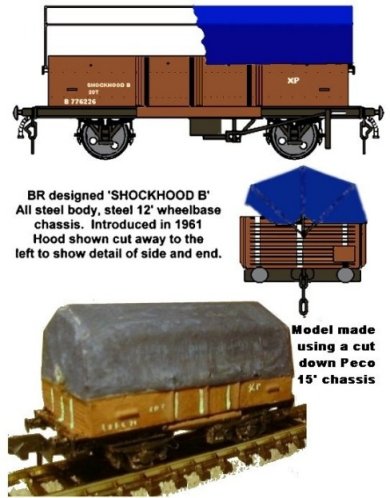
My model of the Shockhood B runs on a cut down Peco fifteen foot
wheelbase chassis. As these had a fixed hood, hiding the inside, they are not
difficult to model. The sides are plain card and the corrugated ends can be cut
from some Slaters corrugated card (my model used the ends from a Peco long
wheelbase tube wagon body. These proved less than ideal.)
As the shock
absorbing vehicles used a shorter than normal body you can reduce the length of
a Peco or Farish open wagon by cutting down to either side of the doors and
sanding slightly to reduce the length by 2mm. Vans are slightly more awkward
and an alternative approach is shown on the shock van below. Here the Peco
chassis was cut diagonally in from each end, producing a triangular section
with the buffers and coupling pocket. The V shaped hole in the end of the
chassis was then packed with strips of 40x40 thou card and the end piece glued
back in place. The coupling pins were cut from the bottom of the body and used
to secure the couplings in place and the body was then glued on top. This
extends the buffers to give the look of a 'shockvan' chassis but keeps the
relationship between the buffers and coupling constant and avoids messing with
the body and roof.
Fig ___ BR 'SHOCKVAN' wagon using a modified Peco
chassis

Hopper Wagons
Many standard mineral wagons had bottom doors fitted, this practice seems to have started in the 1920s (I could be wrong on that), but they still required men to finish the emptying of the wagon. For bulk materials hopper wagons offer some advantages, they do not require men with shovels to unload them which saves a lot of time and manpower, but they do require purpose built facilities to receive them. Hopper wagons were widely used for materials such as coal, crushed limestone and iron ore, early examples from the pre-grouping era were often based on the standard wooden mineral wagons although lacking the side or end doors. These short wooden bodied hoppers remained in widespread use into the 1960s (the Manchester Ship Canal were still building new ones in the late 1950s, possibly later, with steel sheet lining of the floor).
The hopper body extended below the solebars, when modelling an unloaded wagon it is therefore necessary to replicate this. If using a Peco 9 foot wheelbase or Parkside 12 foot wheelbase chassis this is not too difficult, the model shown below however (loosely based on an LNWR loco coal hopper of the 1920s) used a Peco 10 foot wheelbase chassis. The model was made by my god son, his first atempt at kit bashing, he simply cut the door section from a Peco 7 plank wagon and cut back the floor to clear the new angled hopper pieces. He used 1mm scribed card for the replacement door section and the same material for the hopper floor with a rectangle sitting on the chassis top to represent the hopper door. The result is not too bad, although a better model can be produced if you remove the entire side (this avoids the problem of plank lines not matching up) and drill down through the chassis to lower the hopper bottom as described below.
Fig ___ Model of a wooden mineral hopper wagon
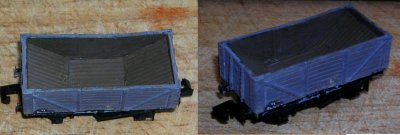
Details of modelling a Furness Railway wooden ore hopper wagon are included in the section on Kit Bashing but a better version of the LNWR/LMS hopper (used for ore as wel as loco coal) is not difficult to make. Take a Peco seven plank wagon kit and cut down the side at each end, just inboard of the corner plate. Scribe along the inside of the sides until these drop off, leaving just the floor and ends of the body. Cut the centre of the floor away just inboard of the coupling plugs, giving you two ends with corner plates and coupking plugs. Use a pointed modelling knife to 'drill' through the centre of the chassis then carve away at the hole until it is square and extends to the line of the axles at each end. Trim the sides of the chassis inside the hole to make them as thin as possible, scraping the sides to give an angle helps. Fir the body ends to the chassis with glue, then add new sides from 1mm scribed card with strapping from 10x20 thou strip. The hopper floor is added using 1mm scribed card, or plain card for a steel sheeted floor, to produce two angled pieces leading down from just below the top plank at the end, into the hole in the floor of the chassis. You will need to trim these to fit the hole, and probably (if you are like me) have to add a little filler to hide the join in that area. Add a strip of 10 thou card under the chassis to represent the hopper doors, these are sufficiently low to look right when the wagon is unloaded. You cannot use the supplied Peco weight but you can add some crushed air-gun pellets inside the body, under the slope of the floor. The sketch below is based on the LNWR design, although that had an eighteen foot long body on a nine feet six inch wheelbase chassis (personally I can live with the easy option of using a Peco chassis, which is accurate for some similar wagons built by the LMS). As well as ore and loco coal wagons of this type were used by the LMS from the early 1930s to supply coal to power stations, similar wagons remained in use into the 1960s on various bulk mineral duties.
Fig ___ Four wheeled mineral hopper wagon

The railways of the north east, and the North Eastern
Railway in particular, had always favoured hopper wagons and the NER had been
building eight plank high twenty-ton four wheeled wooden hopper coal wagons
since the turn of the century. The NER discouraged the use of private owner
wagons, offering its own leased wagons at competitive rates, and by the time of
the 1923 grouping there were over 17,000 of the NER wagons in use. After the
grouping the LNER built 7,000 more to an essentially similar design,
substituting T section angle for the heavy timber ends supports used on the NER
stock.
Fig ___ NER/LNER 20 ton hopper wagons

The NER also built some vary large metal bodied bogie coal hoppers at about the time of the Frst World War, although these were restricted in use to supplying the staiths at the local docks. These bogie wagons are discussed and illustrated in 'Goods Rolling Stock Design - Specialised Rolling Stock' under the heading 'High capacity vehicles'.
By the 1930s metal bodied hopper wagons were commonplace, all the Big Four companies had some for carrying ballast and I believe all had at least some for loco coal duties (I am not sure about the SR though). Private owners operated fleets of iron ore and coal hoppers and the railways in the North of the country continued the development of the type for coal.
In N Gauge a whole range of hopper types have appeared both ready to run and in kit form, for which there are several kit-bashes that can be used to add variety to a rake of wagons. The ex LMS ore hopper shown below left was made using the base of an N Gauge Society iron ore hopper kit with a box of 30 thou card for the upper sides and detail added from strip, these were introduced in the early 1930s and remained in use into the 1960s carrying various mineral cargo. The BR coal wagon shown below right was produced using the sides and upper body ends from the floor section of the kit.
Fig ___ LMS ore hopper and BR coal hopper in BR livery

Coal weighs a lot less than iron ore and hence coal hopper wagons tended to be larger, often running on a 12 foot wheelbase chassis. The LNER 20 ton steel bodied coal hopper of the 1930s was uprated to 21 tons during World War One and formed the basis of the BR standard 21 ton hopper of the post war era. The LMS also used large steel coal hoppers and for coke they developed a higher sided variant with added wooden coke rails round the top. This coke hopper design was also adopted by BR although later BR vehicles had solid ends with the rails only along the sides. One odd application for the type was carrying sand for British Industrial Sand, although I gather this was not a normal traffic and the vehicles used had their side rails removed.
Fig ___ LNER coal and LMS coke hoppers
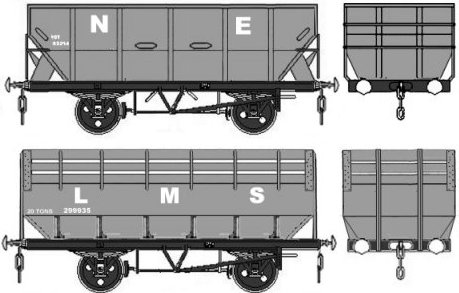
Some cargo required covering in transit and although some open hopper wagons could be used with a tarpaulin draped over them (some even had tarpaulin support rails added) there have been a number of 'covered hopper' wagons produced. There are several advantages to covered hoppers from the modelling point of view, for one thing removable loads are not required. The body itself can be scratch built quite easily as you can cut a central former from card which ends up inside the body but keeps everything true, also the bopper body extending below the solebars can be represented with a blob of milliput on the underside of the chassis.
Covered hoppers were always much less common than the open types however and many were built for a specific traffic flow, a good example being the grain hoppers discussed separately in 'Goods Rolling Stock Design - Specialised Rolling Stock'. Lime is made by heating limestone until it turns to a lumpy powder, it has to be kept dry and a lot of lime was shipped in standard pattern private owner wooden mineral wagons fitted with a peaked roof or fixed tarpaulin support bar. The LMS converted some of its fleet of 10 foot wheelbase 'ore' hoppers (as shown above and which were used for all forms of rock and ore) for lime traffic in the 1930s, adding a peaked roof with double doors on each side. I cannot confirm either the date of introduction or withdrawal of these wagons but later 1930s to late 1960s seems likely, my model is in early BR livery. The model is a simple 'scratch built' body on a Peco chassis.
Fig ___ LMS lime hopper

Only with the advent of BR standard designs did general purpose covered hopper wagons emerge, the 'Covhop', 'Presflo' and 'Prestwin' wagons are discussed and illustrated in 'Goods Rolling Stock Design - BR Designs'.
.
Hopper wagons have to be discharged into under-track bunkers, if
the lay of the land did not allow a track to be run out over a natural drop the
NER built ramped sections of track leading to an elevated coal drop. It was not
advisable to excavate a hollow and run the track over that is it tended to
flood. The NER were in the forefront of hopper use and relatively few ramps and
drops were built outside the North East of the country. Because the facilities
were in place to handle these wagons British Railways actually built a number
of these wagons to maintain services in this area. In the later 1960's BR
decided to shift to the use of hopper wagons for coal, this followed on from
their decision to change to supplying a small number of coal depots from which
local traders would be supplied by road lorry. This in turn meant the building
of more coal drops, usually of brick construction, with the lines running on
heavy steel girders and a roof of corrugated iron sheeting.
In the later 1980s there were experiments with a special conveyor unit that could be slipped under a hopper wagon to allow discharge in locations without a 'drop'. (This 'over rails under loader' (as I believe it was called) was intended for use with the HBA domestic coal hopper wagons, however in practice I do not think it was widely used and I have never traced a decent illustration of the machine.
^
Go to top of page
International Good Guys ~ Making the world a
better place since 1971 ~ Site maintained by

All material Copyright © Mike
Smith 2003 unless otherwise credited


















